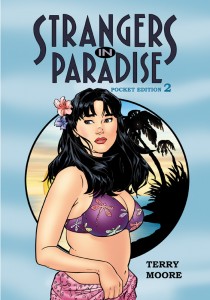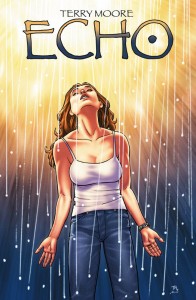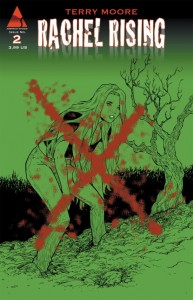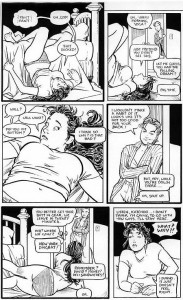
 Terry Moore deserves some kind of award.
Terry Moore deserves some kind of award.
No, not the kind you win for making amazing comic books. He’s already won a couple of those.
No, I mean he needs an award named after him, an award for skillfully telling addictively entertaining stories in serialized graphic form, stories featuring beautiful, empowered women, stories entirely outside the superhero mainstream. That’s pretty much what Moore has been doing for the last twenty years. He’s done a handful of guest stints for DC, Marvel, and Dark Horse, but it’s as the writer and artist of his own self-published series—Strangers in Paradise, Echo, and his current series, Rachel Rising—that Moore has won lasting and well-deserved recognition as a superstar of independent comics.
Come, let me introduce you to the works of this very unusual and very worthy creator.
 Terry Moore made his debut on the comic book scene in the fall of 1993 with a self-contained three-issue mini-series titled Strangers in Paradise. Published in black-and-white by the independent Antarctic Press, SiP (as it came to be known) focused mainly on three characters and their relationship to each other. Francine Peters (who by comic book and media standards would be considered “pudgy”, but who by my much more realistic personal standards is “normal and beautiful”) is sweet but slightly flaky, and has put a lot of energy and (bad) decisions into the so-far-fruitless search for “Mr. Right.” She lives with her best friend since high school, Katina Choovanski, known to one and all as “Katchoo.” An artist with a quick temper and a violent streak, Katchoo is desperately in unrequited love with Francine. David Qin is your stereotypical nice guy, who naturally falls hard for Katchoo when he meets her in a museum.
Terry Moore made his debut on the comic book scene in the fall of 1993 with a self-contained three-issue mini-series titled Strangers in Paradise. Published in black-and-white by the independent Antarctic Press, SiP (as it came to be known) focused mainly on three characters and their relationship to each other. Francine Peters (who by comic book and media standards would be considered “pudgy”, but who by my much more realistic personal standards is “normal and beautiful”) is sweet but slightly flaky, and has put a lot of energy and (bad) decisions into the so-far-fruitless search for “Mr. Right.” She lives with her best friend since high school, Katina Choovanski, known to one and all as “Katchoo.” An artist with a quick temper and a violent streak, Katchoo is desperately in unrequited love with Francine. David Qin is your stereotypical nice guy, who naturally falls hard for Katchoo when he meets her in a museum.
That three-issue mini-series told the story of Francine getting dumped cruelly by her unfaithful, self-involved boyfriend Freddie, which prompts Katchoo to take (some highly questionable) revenge on him, while poor David gets caught up in the goings-on simply because he’s been hanging around trying to get closer to Katchoo.
You probably think that sounds like typical, chick-lit romantic comedy, and on the surface you’d be correct. But several factors made Strangers in Paradise wonderful right out of the gate:
- The story is actually funny. I mean it. Sometimes it gets outright silly, but mostly it’s the kind of fizzy, realistic funny that arises as much from the personalities of the characters themselves (who have a knack for snarky turns of phrase) as from the situations they find themselves in.
- That humor works even better because the story is built on a solid foundation of recognizably genuine human emotions.
- The characters were delightful, the sort of ordinary but appealing people you’d want to hang out with in your own life. (Well, except maybe Katchoo, to whom we are introduced when she blows her alarm clock away with a Smith & Wesson.)
- Moore’s already-accomplished graphic storytelling. Although both his black-and-white art style and his panel-to-panel storytelling skills would continue to develop and improve, even in this first series he shows a strong sense of pacing and telling a story with pictures that are entertaining and informative in their own right.
- SiP was groundbreaking on several fronts, daring to focus on two ordinary young women; one of them was proudly, gloriously apart from the ridiculous and unhealthy body images that even today continue to poison the comic art mainstream, and the other was a lesbian portrayed in a normalized and sympathetic light (her, ahem, complicated past notwithstanding). These and other similar qualities made Strangers in Paradise a favorite of feminist and LGBTQ audiences as it grew into an ongoing series.
Strangers in Paradise returned with a new #1 in late 1994, published by Moore’s own Abstract Studios. That self-published “volume 2” lasted 14 issues before being picked up by Image Comics in 1996 and rebooting again with its third (and final) #1. After an eight-issue run in color, the series returned to its black-and-white self-published status, where it would remain until coming to its (entirely voluntary) conclusion with volume 3, issue 90 in 2007.
When all was said and done, Strangers in Paradise had run for 107 issues, collected in 19 trade paperbacks (and a variety of hardcover and pocket-paperback configurations). What had started as a small-scale romantic comedy had gotten very dark, as the consequences of Katchoo’s difficult past spill over into the present, causing huge complications not just for her relationships with Francine and David but for all their own lives as well. The comic became, at times, a crime story, a political drama, and a mystery in addition to its romantic comedy roots (sometimes all at the same time).
But it always worked, and always felt like Strangers in Paradise, because Moore never lost the characters. Through it all, Francine, David, Katchoo, and the newer characters who enter their orbit (like Freddie’s new fiancée Casey, police detective Mike Walsh, twin assassins Tambi and Bambi, and aging rocker Griffin Silver) all remain recognizably themselves. No matter how crazy the goings-on got (and they occasionally got quite crazy), that warm, relatable, very human foundation made sure that SiP remained one of the best comics I’ve ever read.
Last month, Strangers in Paradise at last became available digitally via ComiXology (which was even reported in USA Today), and Moore recently announced that in 2013 he will publish a Strangers in Paradise sequel novel to honor the series’ 20th anniversary. So now is as good a time as any to get into this unusual and completely wonderful comic story.
After a career-making hit, what next?
 Upon the conclusion of SiP in 2007, Moore faced quite a challenge: after making his name with one very popular and long-lived property, how could he tell a new story with new characters without his fans revolting?
Upon the conclusion of SiP in 2007, Moore faced quite a challenge: after making his name with one very popular and long-lived property, how could he tell a new story with new characters without his fans revolting?
Clearly, he figured it out. In 2008, he debuted Echo, which told the story of a down-on-her-luck photographer named Julie Martin who, after a tragic military disaster in the desert, finds herself involuntarily and irreversibly bonded to a top-secret experimental battle armor. Julie has to go on the run from the government and other, more mysterious forces, in the hopes of surviving long enough to separate herself from the armor without destroying what’s left of her (already deteriorating) life.
When I picked up the first TPB collection of Echo, the visual style was instantly recognizable—no one draws realistically beautiful women and effective physical comedy and drama the way Terry Moore does—but I was seriously impressed by the way Moore was now executing a action-adventure story with vaguely science-fictiony overtones as effectively as he had done “chick-lit”-flavored romantic comedy in Strangers in Paradise.
Echo wrapped (again, voluntarily) with issue 30 in 2011 and has been collected in six trade paperbacks. I’ll be honest: the ending of this series was a bit wobbly, story-wise. But Echo offered a whole lot of great moments and memorably appealing characters on the way to that ending, so I would still give the series as a whole an overall positive review.
 After Echo, Moore did not rest on his laurels, debuting Rachel Rising later in 2011. Again, Moore has shifted genre—Rachel Rising is a horror story about a woman (beautiful and young, of course) who wakes up dead in the forest one night. Apparently unable to die again (despite several good tries), Rachel must figure out not just why she’s walking and talking, but how she wound up dead in the first place. Meanwhile, a mysterious woman who may or may not be behind it all appears to be causing all sorts of horrific and fatal mayhem around town, with a little orphan girl somehow mixed up in it all. And just like he did in SiP, Moore includes non-traditional females in the form of Rachel’s best friend Jet and her entertainingly odd Aunt Johnny.
After Echo, Moore did not rest on his laurels, debuting Rachel Rising later in 2011. Again, Moore has shifted genre—Rachel Rising is a horror story about a woman (beautiful and young, of course) who wakes up dead in the forest one night. Apparently unable to die again (despite several good tries), Rachel must figure out not just why she’s walking and talking, but how she wound up dead in the first place. Meanwhile, a mysterious woman who may or may not be behind it all appears to be causing all sorts of horrific and fatal mayhem around town, with a little orphan girl somehow mixed up in it all. And just like he did in SiP, Moore includes non-traditional females in the form of Rachel’s best friend Jet and her entertainingly odd Aunt Johnny.
With Rachel Rising, Moore isn’t just pushing his storytelling abilities into new genres, he’s pushing himself artistically as well, trying interesting new techniques to tell his story visually.
Now twelve issues in as of this writing, Moore’s latest series is shaping up to be every bit as enjoyable as his first two.
As if all that didn’t speak well enough of him as a creator, Moore has generously shared his artistic and storytelling wisdom in a series of how-to books.
So yeah, I’m a fan, and I think if you’re a connoisseur of graphic storytelling who doesn’t require heroes to be improbably muscled spandex-wearers, you too will be a fan of Terry Moore’s works. Start out with the first trade paperback collections of Echo or Rachel Rising, or the second volume of Strangers in Paradise, the one called I Dream of You (the three-issue miniseries is fun, but it wasn’t until the ongoing series that he worked out the kinks in his style and became the Terry Moore we know and love today.)
And, while you’re at it, someone name an award after this guy already!
